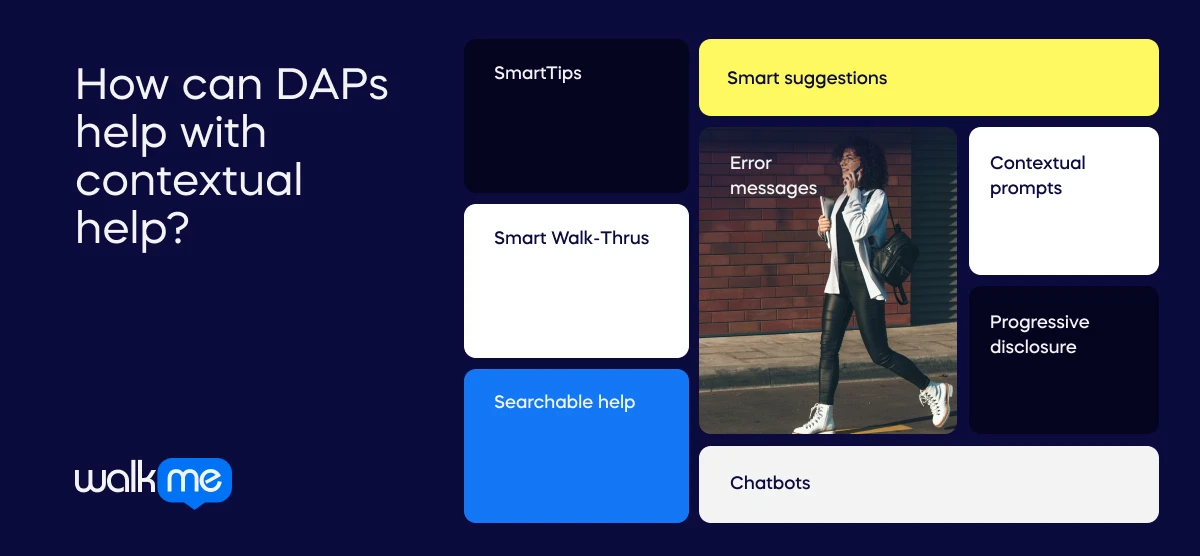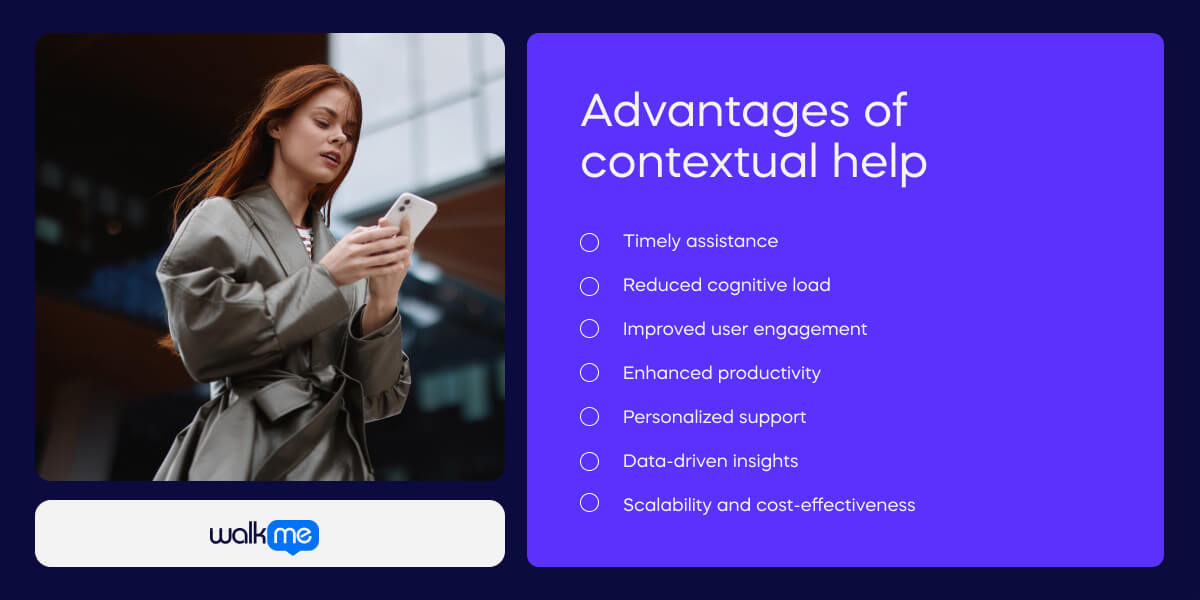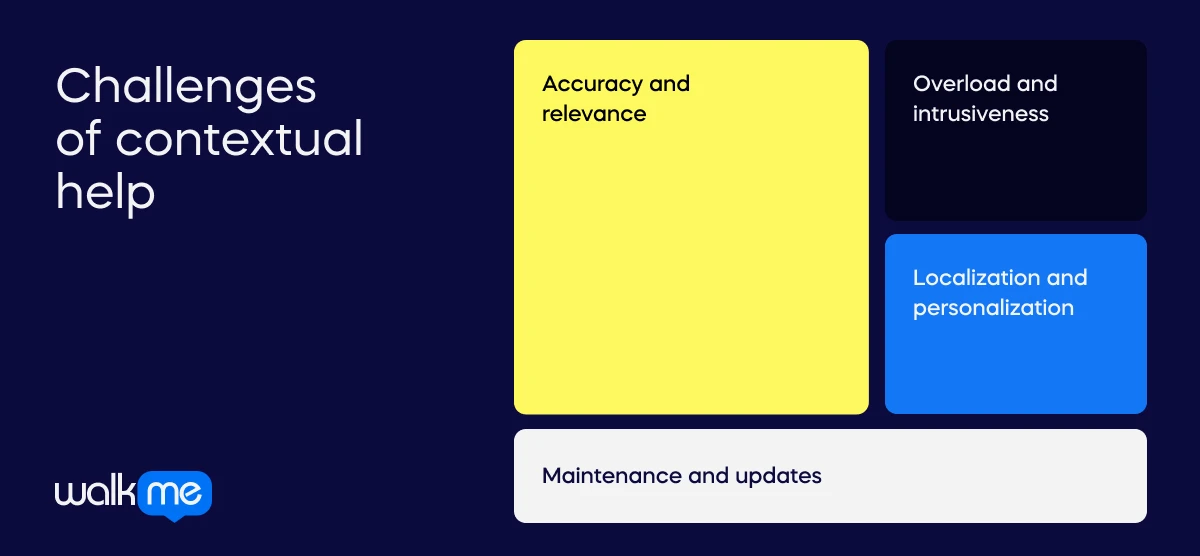What is contextual help?
Contextual help involves people being given the information they need. It is contextual because it is provided based on their current work. Contextual help aims to improve the user experience.

Table of contents
People are given support in a timely and targeted way. As a result, they are less confused and can improve more quickly. When people use contextual help, they can easily overcome problems and find answers. They don’t have to leave the application or get help from elsewhere. As a result, they can use the tool more easily and become more productive quickly. Contextual help is proving to be increasingly important in the digital workplace. Research from BCG shows that 70% of digital transformation projects don’t reach their intended goals. Therefore, features like these can help prevent poor user adoption levels. What’s more, organizations that roll out improvements to software – or new programs – continually need to ensure employees can keep up. By 2027, skills for today’s job market will have changed by 50%. Contextual help is one of the ways to keep employees up to speed.
How can DAPs help with contextual help?

A DAP like WalkMe offers many contextual help features. Here is an overview of what WalkMe can provide:
SmartTips: SmartTips are interactive tooltips. They appear when users hover over specific parts of an application. They provide contextual information. Users understand how to interact with parts of the software. By offering relevant tips at the right moment, SmartTips improves user understanding. They also reduce frustration during software usage.
Smart Walk-Thrus: Smart Walk-Thrus are step-by-step interactive guides that lead users through complex processes. They adapt based on user behavior, ensuring that help is always personalized. Sometimes, contextual prompts appear in Smart Walk-Thrus. These guide people at the exact moment they need help. This helps to improve task completion rates.
Searchable help: Searchable help allows users to find answers quickly. They can look up answers for themselves within the application. This feature provides a knowledge base of articles, FAQs, and troubleshooting steps. Users can access relevant information without leaving the application. This reduces frustration and promotes self-service.
Smart suggestions: Smart suggestions recommend relevant content based on user context. For example, a user may encounter an error or search for help. The system can respond by suggesting related articles or solutions. These proactive recommendations enhance user experience and prevent unnecessary support requests.
Error messages: Well-crafted error messages provide context and actionable guidance. Instead of generic errors, specific messages pinpoint issues and suggest corrective actions. Contextual error messages reduce confusion and empower users to resolve issues by themselves.
Contextual prompts: Contextual prompts appear at specific points in the user journey. They guide users through critical tasks like form submissions or feature introductions. Contextual prompts improve user confidence and efficiency by offering relevant instructions when needed.
Progressive disclosure: Progressive disclosure reveals information gradually, avoiding overwhelming users. For example, a complex setup may reveal information slowly. Basic options will appear first, and advanced settings will appear when relevant. This approach makes the experience simpler and ensures users discover features organically.
Chatbots: Chatbots provide real-time assistance through conversational interfaces. They understand user queries, offer solutions, and guide users step by step. Contextual chatbots enhance user engagement and resolve issues efficiently.
Use cases for contextual help
Contextual help in business
Here are three examples. They show how contextual help can appear in business.
E-commerce website Product recommendations: A customer is browsing a product category. The e-commerce website provides contextual help by recommending related products or accessories. They do this based on their browsing history or items currently in their shopping cart. Guided checkout process: The website offers contextual help when the user checks out. They may highlight certain sections and provide explanations. For example, they might tell the shopper about shipping options or payment methods. Live chat support: The site can provide live chat help if a shopper stays on a product page for a while. This allows the user to ask questions or receive personalized recommendations. It helps to encourage the shopper to make a purchase.
Enterprise software platform In-app training: Employees may need help with a complex enterprise software platform. The company can incorporate contextual help to assist workers. This could be through training modules within the software. It could also be a series of walkthroughs to guide people through workflows. Contextual notifications: The software can use help features. It can tell users about important updates. It can also inform workers about policy changes. Maintenance tasks could be coming up, so the feature can tell users about that. Knowledge base integration: Users can access a knowledge base within the software. They can search for solutions to common issues, view tutorials, or read articles tailored to their current task.
Mobile banking application Transaction help: The app can provide help when users try to transfer money or pay bills. It can explain the steps involved and provide tips. This assistance helps to ensure the transaction is completed accurately and securely. Budgeting tips: Some users often check their account balance or transaction history. The app can offer contextual help to these people. Examples include budgeting tips and expense-tracking tools. They could also provide personalized insights. Security reminders: People will access sensitive features like their account settings. The app can provide help with reminders to use strong passwords. They can also offer biometric authentication. This helps people to protect their data.
Success stories with contextual help
WalkMe has provided contextual help to countless companies. Here’s how the DAP helped IBM:
Challenge: IBM faced challenges with user abandonment. This was due to complex B2B products and a lack of accessible support.
Solution: IBM used WalkMe to aggregate all relevant support resources within their applications. They created a Smart Walk-Thrus for core product features. IBM also integrated WalkMe with Segment, a customer data and analytics platform. This helped them to centralize and connect data across its digital platforms. As a result, they could better understand and analyze their users. They responded to the insights by building personalized in-app user experiences.
Results:
- A 6x increase in product adoption
- A 4x higher conversion rate
- 80% revenue growth in digital offerings
- 300% improvement in product usage, consumption, and retention
Contextual help vs. onboarding tutorials
Contextual help and onboarding tutorials are not quite the same. They both aim to support users when they are using a digital product. However:
- Contextual help provides real-time assistance that is tailored to immediate needs
- Onboarding tutorials provide structured guidance that introduces people to features
Let’s take a further look at how the terms differ:
Contextual help: Purpose: Guide users based on what they are currently doing. Timing: Delivered in real-time while people use the software. Provides immediate support when people encounter challenges or have questions. Form: Can appear as tooltips, inline guidance, pop-up messages, or contextual menus. These offer relevant information or instructions based on what the user is doing. Function: Provide just-in-time support Help users overcome obstacles Allow people to understand features Let users complete tasks more effectively Permits them to understand features without disruption
Onboarding tutorials: Purpose: Designed to introduce users to the main features of a product or software. Typically, this happens when they first start using the interface. Timing: Usually delivered at the beginning of the user journey. It aims to educate users about key features and best practices. Form: Tends to appear as guided walkthroughs, interactive tours, or video tutorials. These introduce people to the interface. They demonstrate how the core functions work and explain how to get started. Function: Assist with user orientation and learning Help users understand the product’s value proposition Show people how to navigate the interface Establish a foundation for further exploration and usage
Advantages of contextual help

Contextual help offers several advantages for both users and businesses:
Timely assistance: Provides support exactly when users need it. Offers relevant information, tips, or instructions in real-time as people navigate the application. This reduces frustration and enhances user satisfaction. Issues or questions can be addressed as they arise.
Reduced cognitive load: Guidance is given while people are using the platform. This reduces cognitive load and decision-making effort. Users can access relevant information without having to search for answers.
Improved user engagement: Encourages users to interact more confidently with the application. They feel supported and empowered to use the product effectively. This can lead to higher retention rates and user adoption.
Enhanced productivity: Users can complete tasks more efficiently and accurately. This reduces the time spent on troubleshooting or learning to use features, and individuals and businesses benefit from this outcome.
Personalized support: This can be tailored to each user’s context, preferences, and needs. The assistance will resonate with their unique situation. This customization fosters a more meaningful and relevant user experience. It increases the likelihood of user success and satisfaction.
Data-driven insights Often include analytics features that track user interactions and behaviors within the application. Businesses can analyze the data and gain valuable insights. They will learn about user needs, pain points, and usage patterns. This can inform iterative improvements to the application and its support resources.
Scalability and cost-effectiveness: This can be automated and integrated directly within the application. This reduces the need for manual support interventions or one-on-one assistance. This scalability and automation make it a cost-effective solution. Support can be provided to a large user base without significant overhead.
Challenges of contextual help

Contextual help has many advantages. But, it also presents challenges. Businesses must address the following:
Accuracy and relevance: Businesses must make sure that the help is relevant. The user must find it useful based on what they are currently doing. It should also be accurate. The user may end up confused or frustrated if it is outdated or incorrect.
Overload and intrusiveness: Tooltips or pop-up messages could overwhelm users. They may feel they are receiving too much information. The features could also interrupt their workflow, leading to a negative user experience. It is important not to go overboard with the amount of contextual help.
Localization and personalization: The help must be localized and personalized. It needs to accommodate users from different regions, languages, and backgrounds. The right resources and planning must be set up for such a venture. Diverse user preferences must be met.
Maintenance and updates: The content and mechanisms require regular maintenance and updates. This is vital so it all remains accurate, relevant, and effective over time. It can be resource-intensive to keep all materials up to date. The guidance must also align with any changes in the application’s features or interface.
The future of contextual help
The role of contextual help is set to become even more integral to the digital experience. As DAPs evolve, they will become more adept at streamlining the process of delivering contextual help. This will likely involve advancements in AI and machine learning. The result will be even more personalized and intuitive support. The goal will be to create systems that solve users’ immediate problems and anticipate their future needs. They will, therefore, foster an environment of seamless interaction and sustained engagement. In essence, the future of contextual help is one where assistance is not just available but is proactively offered. This ensures users feel supported at every step of their digital journey. As DAPs become more sophisticated, we can expect them to play a pivotal role in realizing this vision. This will make contextual help an indispensable element of the digital landscape.